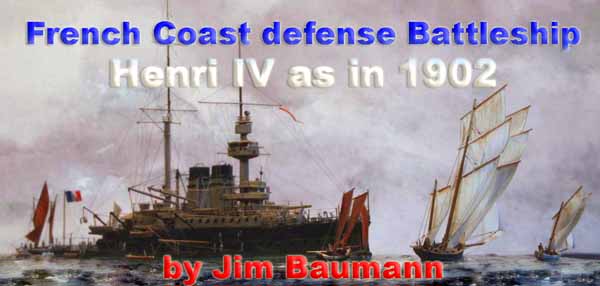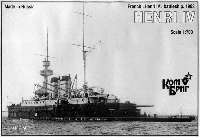

Henri IV was laid down in July 1897,
launched in August 1899 and completed in 1902, designated as a coast defense
battleship. She was never in the forefront of French naval activities.
Designed by the noted innovative French naval architect Emile Bertin, she
was effectively a sea-going monitor of unusual design, combining a a low-freeboard
hull-giving a steady gun platform-with a built up superstructure to ensure
seaworthiness. Her most noteworthy feature was the introduction of the
super-firing turret concept. She was at Bizerta in the Mediterranean and
remained there as guard ship until February 1915. Thereafter she was sent
to the Dardanelle’s to support the British and French fleet and the ANZAC
Gallipoli landings. 1916 found her attached to the Reserve Division of
the 3rd Battle Squadron. She served with the French Eastern division in
Egypt and was used in 1918 at Taranto as a depot ship. After returning
to Toulon at the end of WW1 saw her being surplus to requirements, she
was stricken from the navy and broken up in 1921
|
||||||||||||||||||||||||||||||||||||||||
| Building the Model | ||||||||||||||||||||||||||||||||||||||||
| The 1/700 resin
kit of Henri IV is of the latest generation of beautifully designed
and engineered products from Combrig. Dimensionally the model checked out
almost perfectly. All tricky detail such as the circular and square event
stacks were finely executed. The main downside being the lack of representation
of the square scuttles on the sides of the hull, in three rows. On the
real ship these scuttles were square windows-with a square drop down shutter
- within was set a round porthole. The hull casting has the round portholes
only, i.e. the shutter in the closed position.
I contemplated suggesting the closed lids with careful painting—alas the effect I achieved was …awful! Careful study of available photos showed the scuttles to be open virtually at all times; I therefore elected to represent the square opening with small brass PE ladder-stock cut into small squares, carefully painting the interior a darker colour and then setting them off with a raised scuttle-lid made of paper infused with CA glue. |
to enlarge |
|||||||||||||||||||||||||||||||||||||||
 |
||||||||||||||||||||||||||||||||||||||||
 |
||||||||||||||||||||||||||||||||||||||||
 |
||||||||||||||||||||||||||||||||||||||||
| This was a time consuming exercise – but the end effect was rewarding,
the hull looking far more interesting as well as more like the photos of
the real thing! Study of photos revealed the position of a number of doors
on the hull and superstructure. The bridge had all the stairs added early
on—as these would later become inaccessible
Henri IV had an extensive system of large crane-booms and davits for launching the boats from the narrow superstructure out beyond the wide low weather-deck. The Combrig mast parts are somewhat simplified, lacking the X-cross bracing fore and aft as well as on the lower sides. I made these using thin sections of brass PE strip |
 |
|||||||||||||||||||||||||||||||||||||||
| These booms were stowed at an elevated angle fore/aft alongside the
funnels when underway —but at anchor the looked like a giant spider with
booms sticking out at various angles-so the decision of a static display
was easily reached. I decided on the year 1902 as she carried at this time
the tallest topmasts and also had the lower funnel flanges painted black
-a look I liked very much.
The clever kit design made light work of fitting the numerous separately cast vents easily achieved with clean paint demarcation. A small PE sheet supplied the foremasts fighting top-platform as a fold -up structure. The individual PE braces underneath-whilst challenging added much to the appearance of the finished structure |
 |
|||||||||||||||||||||||||||||||||||||||
| Examination of ship photos as well the fine model in the
Musee de Marine in Paris showed the platform to carry an awning frame-which
as far as I could ascertain carried an awning at all times sometimes with
the sides rolled down fully, whilst other photos showed these to be partially
raised –underway as well as at anchor!
I decided to show the partially raised scenario-as this was visually most interesting! I made the awning frame of fine copper wire and encircled it with a stretched sprue perimeter. This was in filled with thinned white glue to represent the canvas roof. Subsequent applications of white glue represented the rolled-up side awnings. |
 |
|||||||||||||||||||||||||||||||||||||||
 |
||||||||||||||||||||||||||||||||||||||||
| At the same time the bridge awnings and canvas dodgers on rails were made in a similar fashion, care being take to achieve a clean separation line between the dodger and the railing. |  |
|||||||||||||||||||||||||||||||||||||||
| Study of photos showed that Henri IV carried extensive awnings when at anchor. Looking at one of the many fine postcards from my collection of Henri IV I was tempted to represent the large aft awning sometimes carried over the aft deck, but in miniature form I felt this may unbalance the model. Fortunately other photos showed a small awning carried over the 5.5 aft turret only…! This awning was made in the same manner as described above. |  |
|||||||||||||||||||||||||||||||||||||||
 |
||||||||||||||||||||||||||||||||||||||||
 |
||||||||||||||||||||||||||||||||||||||||
| A this stage I wanted to make the ship-at-anchor-diorama a little more
interesting visually with the addition of a local Breton sailing fishing
boat.
I was inspired by the lofty rigs of the ‘Bisquines’, a sailing trawler/dragger working the Oyster banks of the St.Malo bay . These operations required massive motive power-hence the vast sail areas. On regatta days they carried the additional top-gallant sails; the magnificent appearance of these tall, vast lug sailed rigs, on unstayed pole masts of diverging angles … was fascinating! A bit of research soon elicited a plethora of suitable background information as well as photos and plans. |
 |
|||||||||||||||||||||||||||||||||||||||
| Now fired up with enthusiasm for the historical aspects
of working sail… I decided to show the model at anchor off a small town
on the Brittany coast—during the regional Fisherman's regatta day … thereby
permitting a small homage to Breton working sailing boats in miniature….
The Bisquine hull was carved of hardwood, the bulwarks hollowed out with a small burr in a motor tool ,deck structures and hatches added of styrene strip. Gunwale strips and strakes were made of fine stretched sprue. The tall tapering pole masts were made of fine stainless steel welding rod tapered in a drill and profiled using files and emery paper. At the same time I started on other hulls…. |
||||||||||||||||||||||||||||||||||||||||
 |
||||||||||||||||||||||||||||||||||||||||
|
 |
|||||||||||||||||||||||||||||||||||||||
 |
||||||||||||||||||||||||||||||||||||||||
| The hulls were carved and shaped to the chosen angle of
heel – a fresh breeze had sprung up- and then placed onto the water base
prior to installing sails and spars.
The sails were made of thin paper, shaped with the use of toothpicks to induce the upper sail twist that boom and vangless sails exhibit in a fresh wind. When satisfied with the shape, they were attached to the masts with thinned white glue and then infused with CA . The spars were the attached with matte varnish-over-length-and snipped off to size in situ. |
 |
|||||||||||||||||||||||||||||||||||||||
 |
||||||||||||||||||||||||||||||||||||||||
| The ship and the racing fishing craft were crewed liberally with adapted and repainted Eduard pre-coloured figures. A rowing gig was placed alongside the ship-the crew of naval ratings pulling hard…. |  |
|||||||||||||||||||||||||||||||||||||||
| The remainder of the build was quite straightforward-if
a little fiddly due to the fragile booms projecting everywhere… The
mooring buoy was made of scrap styrene parts-with the heavy warps fashioned
of thin lead wire. The buoy and the ship were carefully positioned taking
into account the depicted wind direction and the strong tidal streams prevalent
off the Brittany coast.
The 47mm guns on the boat deck -as seen in all the photos- had canvas covers made of draped white glue. |
||||||||||||||||||||||||||||||||||||||||
| On the Bridge, the poles with large globes-the purpose of which is still not clear to me- were made of copper-wire and white glue-the kit items (which were nice) lacking the pole extension above… |  |
|||||||||||||||||||||||||||||||||||||||
| The final flat-coat-prior to the rigging stage-nearly spelt the end of this project…. A ‘bad’ can of aerosol Matte varnish turned the entire diorama into an arctic scene with wonderful ice effects-alas not appropriate for a breezy summer day of the French coast…. |  |
|||||||||||||||||||||||||||||||||||||||
 |
||||||||||||||||||||||||||||||||||||||||
| Having overcome the shock of seeing the potential ruination of this project occur with seconds…. I hunted for a solution…as it transpired… literally. Oddly enough, Cyanacrilite accelerator spray ( Zap Kicker) acted as a successful colour restorer. With a further coating of (good!) matte varnish the project was rescued…. A lesson learnt - always do a test-spray!!! |  |
|||||||||||||||||||||||||||||||||||||||
The rigging was carried out entirely using stretched sprue
in black and various brown tones-to differentiate between standing and
running rigging. The French Ensign, which flew from a remarkably tall ensign
staff- was made using thin paper and coloured pencils, the colour demarcation
being masked using Tamiya tape.
|
||||||||||||||||||||||||||||||||||||||||
| In conclusion Combrig have supplied a first class starting point for
a model of this innovative—but overlooked French Battleship. With the exception
of the aforementioned scuttle issue-the dimensions and detailing is simply
first class. It is definitely not a kit for beginners.
I thoroughly enjoyed building and researching this unusual vessel. It most certainly is not the last French Pre-Dreadnought in my building schedule… |
 |
|||||||||||||||||||||||||||||||||||||||
I must thank all my virtual e-friend who immediately sent
me a number of excellent and useful images of this somewhat obscure ship:
|
||||||||||||||||||||||||||||||||||||||||
| More of Jim Baumann's work. | ||||||||||||||||||||||||||||||||||||||||